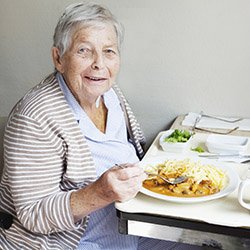How can I support rehabilitation of care home residents after COVID-19?

Rehabilitation for people in long-term care can improve function and counter lockdown effects, and nurses have a key role to play in this

The implementation of social distancing and lockdown measures to protect lives during the COVID-19 pandemic was unprecedented. These measures have presented challenges in maintaining a physically active lifestyle, especially for older adults (Cunningham and O’Sullivan 2020).
Care homes have been considerably affected by the pandemic due to the vulnerability of their populations. Residents often have complex needs, with a high prevalence of multimorbidity, functional dependency, cognitive impairment (Gordon et al 2014) and frailty.
Frailty can be associated with disability and disease, affecting a person’s ability to undertake activities of daily living, and is linked with reduced independence, depression and poorer quality of life (Tiberini and Richardson 2015, Dent et al 2019).

Social isolation and loneliness can contribute to functional decline
Despite limited data at the time of writing, early evidence shows that the most commonly reported symptoms following COVID-19 include breathlessness, fatigue and brain fog (Scottish Intercollegiate Guidelines Network (SIGN) 2020).
There is also evidence that social isolation and loneliness can contribute to functional decline (Gale et al 2018). Therefore, even though the long-term effect of COVID-19 in care homes is still unknown, anecdotally it has affected residents’ overall function, regardless of whether they have had coronavirus.
Physical rehabilitation for older people in long-term care can support improvement in function, and first-line therapy for the management of frailty should include resistance-based exercise (Crocker et al 2013, Dent et al 2019). Therefore, rehabilitation must be promoted for this population, focusing on individual goals to improve function and quality of life by enabling people to be as active and productive as possible.
Rehabilitative palliative care promotes the concept of living well and actively until death (Tiberini and Richardson 2015) and is fundamental when considering frailty and post-COVID rehabilitation for care home residents. It involves four main components and aims to optimise people’s function and well-being to enable them to live as fully and independently as possible (Crocker et al 2013, Tiberini and Richardson 2015, SIGN 2020).
Four main components of rehabilitative palliative care
 1. Person-centred goal setting: this should be at the heart of care to establish that people feel listened to and that their priorities are paramount
1. Person-centred goal setting: this should be at the heart of care to establish that people feel listened to and that their priorities are paramount
Top tip: Explore with residents what is important to them and what they would like to achieve. Ask questions such as ‘What is important to you today?’ and ‘What would you like to achieve in the next short while?’
 2. Focus on function beyond symptoms: maintaining function is important to preserve independence and a priority for most people, but it is easier to maintain function than regain it
2. Focus on function beyond symptoms: maintaining function is important to preserve independence and a priority for most people, but it is easier to maintain function than regain it
Top tips: Assess residents’ physical function on a regular basis and establish what they can do, and encourage daily functional activity and training
Recognise that symptoms can affect function and proactively refer to a specialist for symptom management if required, for example if breathlessness is limiting mobility a person might benefit from techniques to optimise function
 3. Enablement: this supports participation and independence and should always be led by a person’s willingness and capacity to engage
3. Enablement: this supports participation and independence and should always be led by a person’s willingness and capacity to engage
Top tip: Always give someone the choice to participate by enabling them to do as much for themselves as they can
 4. Self-management: this supports people to ‘take charge’ of their own health and well-being
4. Self-management: this supports people to ‘take charge’ of their own health and well-being
Top tips: Empower and encourage independence and self-care whenever possible, for example allow people to participate in activities of daily living such as washing, dressing and eating within their abilities
Use self-management strategies for symptoms such as breathlessness
(Sources: Crocker et al 2013, Tiberini and Richardson 2015, SIGN 2020)
Practice Question is written by members of the Nurses and AHPs Council of the British Geriatrics Society
Find out more
- St Christopher’s (2021) Managing Breathlessness
- All Ireland Institute of Hospice and Palliative Care (2019) Rehabilitative Palliative Care
References
- Crocker T, Forster A, Young J et al (2013) Physical rehabilitation for older people in long-term care. Cochrane Database of Systematic Reviews. Issue 2. CD004294. doi: 10.1002/14651858.CD004294.pub3
- Cunningham C, O’Sullivan R (2020) Why physical activity matters for older adults in a time of pandemic. European Review of Aging and Physical Activity. 17:16. doi: 10.1186/s11556-020-00249-3
- Dent E, Morley JE, Cruz-Jentoft AJ et al (2019) Physical Frailty: ICFSR International Clinical Practice Guidelines for Identification and Management. Journal of Nutrition, Health & Aging. 23, 9, 771-787. doi: 10.1007/s12603-019-1273-z
- Gale CR, Westbury L, Cooper C (2018) Social isolation and loneliness as risk factors for the progression of frailty: the English Longitudinal Study of Ageing. Age and Ageing. 47, 3, 392-397. doi: 10.1093/ageing/afx188
- Gordon AL, Franklin M, Bradshaw L et al (2014) Health status of UK care home residents: a cohort study. Age and Ageing. 43, 1, 97-103. doi: 10.1093/ageing/aft077
- Scottish Intercollegiate Guidelines Network (2020) SIGN 161 Managing the Long-Term Effects of COVID-19: National Guidance for Identification, Assessment and Management
- Tiberini R, Richardson H (2015) Rehabilitative Palliative Care: Enabling People to Live Fully Until They Die
